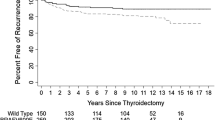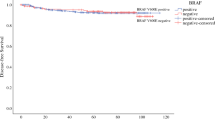Abstract
Background
The BRAFV600E mutation is the most common genetic alteration found in papillary thyroid cancer (PTC). Recent studies show that this mutation occurs more frequently in patients with PTC showing aggressive clinicopathologic features. The aim of the present study was to evaluate the prevalence of the BRAFV600E mutation in tumor samples and its association with high-risk clinicopathologic features prospectively.
Patients and methods
From February 2009 to January 2010, 547 PTC patients who underwent surgery in Seoul National University Hospital were enrolled in the study. Polymerase chain reaction was used to amplify exon 15 of the BRAF gene from paraffin-embedded thyroid tumor specimens, followed by direct sequencing to detect the BRAFV600E mutation. Both univariate and multivariate analyses were performed to analyze associations between the BRAFV600E mutation and clinicopathologic features.
Results
The BRAFV600E mutation was found in 381/547 (69.7%) patients with primary PTC. The BRAFV600E mutation was significantly associated with age (≥45 years), tumor size (>1 cm), extrathyroidal extension, and cervical lymph node metastases (P < 0.05). Multiple logistic regression showed that it was significantly associated with gender (OR = 1.834; 95% CI 1.021–3.463), tumor size (OR = 1.972; 95% CI 1.250–3.103), and extra-thyroidal extension (OR = 2.428; 95% CI 1.484–3.992), but not with age, multifocality, lymph node metastases, and advanced disease stage. The proportion of BRAFV600E mutation was significantly associated with the number of high-risk factors of tumor recurrence (P < 0.001).
Conclusions
The BRAFV600E mutation was associated with high-risk clinicopathologic characteristics in patients with PTC. The BRAFV600E mutation may be a potential prognostic factor in PTC patients.
Similar content being viewed by others
References
Davies H, Bignell GR, Cox C et al (2002) Mutations of the BRAF gene in human cancer. Nature 417:949–954
Garnett MJ, Marais R (2004) Guilty as charged: B-RAF is a human oncogene. Cancer Cell 6:313–319
Mercer KE, Pritchard CA (2003) Raf proteins and cancer: B-Raf is identified as a mutational target. Biochem Biophys Acta 1653:25–40
Hilger RA, Scheulen ME, Strumberg D (2002) The Ras-Raf-MEKERK pathway in the treatment of cancer. Onkologie 25:511–518
Mazzaferri EL, Young RL (1981) Papillary thyroid carcinoma: a 10-year follow-up report of the impact of therapy in 576 patients. Am J Med 70:511–518
Ries LAG, Melbert D, Krapcho M et al. (2007) SEER Cancer Statistics Review, 1975–2004. Bethesda, MD: National Cancer Institute. http://seer.cancer.gov/csr/1975-2004/, based on November 2006 SEER data submission, posted to the SEER web site
Mazzaferri EL (2006) An overview of the management of thyroid cancer. In: Mazzaferri EL, Harmer C, Mallick UK, Kendall-Taylor P (eds) Practical Management of Thyroid Cancer: A Multidisciplinary Approach. Springer-Verlag, London, pp 1–28
DeGroot LJ, Kaplan EL, McCormick M et al (1990) Natural history, treatment, and course of papillary thyroid carcinoma. J Clin Endocrinol Metab 71:414–424
Tanaka K, Sonoo H, Hirono M et al (2005) Retrospective analysis of predictive factors for recurrence after curatively resected papillary thyroid carcinoma. Surg Today 35:714–719
Kim KH, Kang DW, Kim SH et al (2004) Mutations of the BRAF gene in papillary thyroid carcinoma in a Korean population. Yonsei Med J 45:818–821
Nikiforova MN, Kimura ET, Gandhi M et al (2003) BRAF mutations in thyroid tumors are restricted to papillary carcinomas and anaplastic or poorly differentiated carcinomas arising from papillary carcinomas. J Clin Endocrinol Metab 88:5399–5404
Namba H, Nakashima M, Hayashi T et al (2003) Clinical implication of hot spot BRAF mutation, V599E, in papillary thyroid cancers. J Clin Endocrinol Metab 88:4393–4397
Vasko V, Hu S, Wu G et al (2005) High prevalence and possible de novo formation of BRAF mutation in metastasized papillary thyroid cancer in lymph nodes. J Clin Endocrinol Metab 90:5265–5269
Xing M, Westra WH, Tufano RP et al (2005) BRAF mutation predicts a poorer clinical prognosis for papillary thyroid cancer. J Clin Endocrinol Metab 90:6373–6379
Fugazzola L, Mannavola D, Cirello V et al (2004) BRAF mutations in an Italian cohort of thyroid cancers. Clin Endocrinol 61:239–243
Puxeddu E, Moretti S, Elisei R et al (2004) BRAF(V599E) mutation is the leading genetic event in adult sporadic papillary thyroid carcinomas. J Clin Endocrinol Metab 89:2414–2420
Ito Y, Yoshida H, Maruo R et al (2009) BRAF mutation in papillary thyroid carcinoma in a Japanese population: its lack of correlation with high-risk clinicopathologic features and disease-free survival of patients. Endocrine J 56:89–97
Nucera C, Goldfarb M, Hodin R et al (2009) Role of B-Raf (V600E) in differentiated thyroid cancer and preclinical validation of compounds against B-Raf (V600E). Biochimica et Biophysica Acta 1795(2):152–161
Lee JH, Lee ES, Kim YS (2007) Clinicopathologic significance of BRAF V600E mutation in papillary carcinomas of the thyroid. Cancer 110:38–46
Xing M (2007) BRAF mutation in papillary thyroid cancer: pathogenic role, molecular bases, and clinical implications. Endocr Rev 28:742–762
Kim TY, Kim WB, Rhee YS et al (2006) The BRAF mutation is useful for prediction of clinical recurrence in low-risk patients with conventional papillary thyroid carcinoma. Clin Endocrinol (Oxf) 65:364–368
Lee JH, Lee ES, Kim YS et al (2006) BRAF mutation and AKAP9 expression in sporadic papillary thyroid carcinomas. Pathology 38:201–204
Kim KH, Suh KS, Kang DW et al (2005) Mutations of the BRAF gene in papillary thyroid carcinoma and in Hashimoto’s thyroiditis. Pathol Int 55:540–545
Park SY, Park YJ, Lee YJ et al (2006) Analysis of differential BRAF (V600E) mutational status in multifocal papillary thyroid carcinoma: evidence of independent clonal origin in distinct tumor foci. Cancer 107:1831–1838
Lupi C, Giannini R, Ugolini C et al (2007) Association of BRAF V600E mutation with poor clinicopathologic outcomes in 500 consecutive cases of papillary thyroid carcinoma. J Clin Endocrinol Metab 92:4085–4090
Kebebew E, Weng J, Bauer J et al (2007) The prevalence and prognostic value of BRAF mutation in thyroid cancer. Ann Surg 246:466–471
Elisei R, Ugolini C, Viola D et al (2008) BRAF(V600E) mutation and outcome of patients with papillary thyroid carcinoma: a 15-year median follow-up study. Clin Endocrinol Metab 93:3943–3949
Trovisco V, Soares P, Preto A et al (2005) Type and prevalence of BRAF mutations are closely associated with papillary thyroid carcinoma histotype and patients’ age but not with tumour aggressiveness. Virchows Arch 446:589–595
Abubaker J, Jehan Z, Bavi P et al (2008) Clinicopathological analysis of papillary thyroid cancer with PIK3CA alterations in a Middle Eastern population. J Clin Endocrinol Metab 93:611–618
Liu RT, Chen YJ, Chou FF et al (2005) No correlation between BRAFV600E mutation and clinicopathological features of papillary thyroid carcinomas in Taiwan. Clin Endocrinol (Oxf) 63:461–466
Guan H, Ji M, Bao R et al (2009) Association of high iodine intake with the T1799A BRAF mutation in papillary thyroid cancer. J Clin Endocrinol Metab 94:1612–1617
Frasca F, Nucera C, Pellegriti G et al (2008) BRAF(V600E) mutation and the biology of papillary thyroid cancer. Endocr Relat Cancer 15:191–205
Vriens MR, Suh I, Moses W et al (2009) Clinical features and genetic predisposition to hereditary nonmedullary thyroid cancer. Thyroid 19:1343–1349
Jo YS, Li S, Song JH et al (2006) Influence of the BRAFV600E mutation on expression of vascular endothelial growth factor in papillary thyroid cancer. J Clin Endocrinol Metab 91:3667–3670
Fugazzola L, Puxeddu E, Avenia N et al (2006) Correlation between B-RAFV600E mutation and clinicopathologic parameters in papillary thyroid carcinoma: data from a multicentric Italian study and review of the literature. Endocr Relat Cancer 13:455–464
Rodolico V, Cabibi D, Pizzolanti G et al (2007) BRAF(V600E) mutation and p27(kip1) expression in papillary carcinomas of the thyroid ≤ 1 cm and their paired lymph node metastases. Cancer 110:1218–1226
Powell N, Jeremiah S, Morishita M et al (2005) Frequency of BRAF T1796A mutation in papillary thyroid carcinoma relates to age of patient at diagnosis and not to radiation exposure. J Pathol 205:558–564
Xu X, Quiros RM, Gattuso P et al (2003) High prevalence of BRAF gene mutation in papillary thyroid carcinomas and thyroid tumor cell lines. Cancer Res 63:4561–4567
Chung KW, Yang SK, Lee GK et al (2006) Detection of BRAFV600E mutation on fine needle aspiration specimens of thyroid nodule refines cyto-pathology diagnosis, especially in BRAF600E mutation-prevalent area. Clin Endocrinol (Oxf) 65:660–666
Kim TY, Kim WB, Song JY et al (2005) The BRAF mutation is not associcated with poor prognostic factors in Korean patients with conventional papillary thyroid microcarcinoma. Clin Endocrinol (Oxf) 63:588–593
Renshau AA (2005) Papillary carcinoma of the thyroid ≤ 1.0 cm: rarely incidental or occult anymore. Cancer 105:217–219
Pelizzo MR, Boschin IM, Toniato A et al (2004) Natural history, diagnosis, treatment and outcome of papillary thyroid microcarcinoma (PTMC): a mono-institutional 12-year experience. Nucl Med Commun 25:547–552
Park YJ, Kim YA, Lee YJ et al (2010) Papillary microcarcinoma in comparison with larger papillary thyroid carcinoma in BRAFV600E mutation, clicnicopathological features, and immunohistochemical findings. Head Neck 32:38–45
Author information
Authors and Affiliations
Corresponding author
Rights and permissions
About this article
Cite this article
Kim, Sj., Lee, K.E., Myong, J.P. et al. BRAFV600E Mutation is Associated with Tumor Aggressiveness in Papillary Thyroid Cancer. World J Surg 36, 310–317 (2012). https://doi.org/10.1007/s00268-011-1383-1
Published:
Issue Date:
DOI: https://doi.org/10.1007/s00268-011-1383-1




